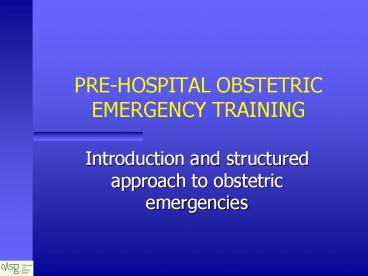PRE-HOSPITAL OBSTETRIC EMERGENCY TRAINING - PowerPoint PPT Presentation
1 / 28
Title:
PRE-HOSPITAL OBSTETRIC EMERGENCY TRAINING
Description:
PRE-HOSPITAL OBSTETRIC EMERGENCY TRAINING Introduction and structured approach to obstetric emergencies INSTRUCTOR NOTES You might want to mention the following ... – PowerPoint PPT presentation
Number of Views:1553
Avg rating:3.0/5.0
Title: PRE-HOSPITAL OBSTETRIC EMERGENCY TRAINING
1
PRE-HOSPITAL OBSTETRIC EMERGENCY TRAINING
- Introduction and structured approach to obstetric
emergencies
2
Course aims
- To provide the knowledge necessary to save the
mother and fetus in life threatening
circumstances - To teach the practical procedures necessary to
save the mother and fetus in life threatening
circumstances - To test the acquisition of this knowledge and
skills
3
Course Content
Theory VLE/Course Manual Lectures Workshops Discussions
Practical Skill Stations Demonstrations Scenarios
Testing Continual assessment OSCE Scenarios
4
Course Structure
- Day 1
- Normal delivery
- Primary and secondary survey
- Emergencies in pregnancy
- Assessment OSCE Scenarios
- Day 2
- Emergencies during and post delivery
- Non-obstetric emergencies
- Newborn resuscitation
- Assessment OSCE Scenarios
5
Evaluation and Support
- Continual assessment
- Regular feedback
- Re-evaluation if problems identified
- Structured critiquing
- What went well
- What could be improved upon
- Mentoring
6
Introductions
- Faculty
- Meet your mentor
- Candidates
- Housekeeping
7
Structured ApproachObjectives
- Review the correct sequence to be followed in
assessing and managing all seriously ill or
injured patients - Review the concept of primary and secondary
survey - Understand how that concept adapts to the
pregnant patient
8
The pregnant patient
- It is essential to understand the physiological
changes that occur in pregnancy and the impact
this has on assessment and management
Best Way To Save The Fetus Is To Adequately
Resuscitate The Mother
9
Quick scan assessment
- On approach
- Airway
- Breathing
- Circulation
- Disability
- Environment
- Fundus
- Get to the point quickly
10
Full primary survey
- Remember that there are two patients
- Remember that the aim is to
- Identify life threatening problems
- Instigate rapid management
- Determine the priority for transportation early
11
Primary surveyAirway with positioning -
assessment
- Ensure patients beyond the first stage of
pregnancy are not lying flat on their back - Is the patient talking?
- Is the patient making unusual sounds?
- Is the patient responsive?
12
Primary surveyAirway key points
- Position obstetric patients with a 15 to 30
degree tilt to the left - Manage airway problems definitively before moving
on - Get help (or get the patient to help) if you are
unable to open an obstructed airway - Dont get distracted from A by other problems
13
Primary surveyBreathing
- Document respiratory rate and effort
- Obtain oxygen saturations ASAP
- Auscultate for sounds
- Assess for cyanosis
- Give oxygen based on clinical findings
14
Primary surveyBreathing key points
- Dont alarm the patient by giving oxygen when
labour is progressing normally - Rates less than 10 or greater than 29 require
ventilatory support - Increased respiratory rates without increased
work of breathing may indicate compensation for a
C problem
15
Primary Survey with ResuscitationCirculation
- Document radial pulse and volume
- Document blood pressure
- Assess skin colour and temperature (to touch)
- Assess for bleeding
- Blood on the floor and five more
- Vaginal bleeding bleeding in the chest, abdomen,
pelvis and long bones
16
Primary Survey with ResuscitationCirculation
key points
- The treatment of APH is surgery in a hospital
obstetric unit - Fluids should be started on route (if needed)
- There is good evidence that short on-scene times
and pre-alerting the hospital saves lives - In a full-term woman in labour, any blood loss
making a stain larger in diameter than a drinks
coaster is cause for significant concern
17
Primary SurveyDisability AVPU, Pupils, Posture
- Posture
- Normal
- Fitting
- Decorticate / decerebrate
A
lert
V
oice
Responds to
P
ain
Responds to
U
nresponsive
Pupils - PEARLA
18
Primary SurveyExamine, Environment, Evaluate
- Briefly examine the introitus
- Consider the environment
- Evaluate early for priority
19
Primary SurveyEnvironment key points
- Avoid delivering the baby in the back of the
ambulance - Listen to your colleagues
20
Primary surveyFundus
- Make a quick assessment of fundal height
- Below umbilicus lt 22 weeks
- Above umbilicus gt 22 weeks
Do not delay the transportation of the mother by
attempting to determine fetal wellbeing
21
Primary SurveyGet to the point quickly
- Significant blood loss
- Cervical shock
- Suspected abruption, placenta praevia or uterine
rupture - Eclampsia or significant hypertension
22
Primary SurveyGet to the point quickly
- Maternal cardiac arrest
- Newborn cardiac arrest
- Newborn with poor vital signs
- Shoulder dystocia
- Cord prolapse
- Suspected AFE
- Retained placenta
- Uterine inversion
23
Obstetric history
- Previous medical history
- Past obstetric history
- Previous pregnancies
- Current pregnancy
- History of current problem
Do not forget to access the patients hand-held
records
24
History of current problem
- Bleeding
- Fit
- Pain
- Discharge
- Labour
- Fetal movements
25
Evaluating the history
- Assess for risk factors
- Assess symptom severity
- Attempt to make a diagnosis
- Use examination findings to confirm diagnosis
26
Obstetric secondary survey
- A, B, C
- Blood pressure
- Medical, surgical and obstetric history
- Blood loss
- SROM assess liquor
- Abdominal examination
- If contracting, palpate for contractions
- Vulval inspection if woman is feeling pushy
27
Structured approach
Any Questions?
28
Structured ApproachSummary
- Quick scan assessment
- Primary survey and resuscitation
- Taking and evaluating an obstetric history
- Hand-held records are invaluable
- Obstetric secondary survey
Continuous re-evaluation

